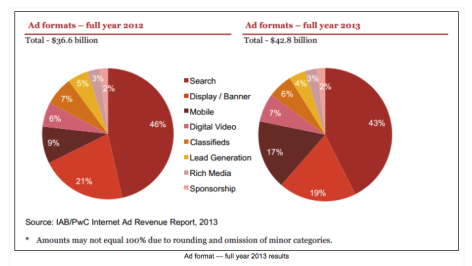More advertisers are taking advantage of online video advertising opportunities.
According to the IAB Internet Advertising Revenue Report for 2013, online video ads are increasing in popularity, rising up to become the fourth largest ad format after search, display/banner and mobile. Meanwhile, search and display ads are losing ground.
To round things off, here are some recent YouTube video statistics:
- 100 hours of video are uploaded to YouTube every minute
- Google has more than a million advertisers using Google ad platforms (majority are small businesses)
Anatomy Of A Good Video Ad
A good video as is, obviously, the foundation of an effective video campaign. Following are some things you’ll want to consider when putting together your video.
Is It Worth Watching?
The most important success factor for video advertising is that the content is worth watching. After all, your ad will be interrupting or distracting users from other possibly more important intentions. Video ads that aren’t worth watching are a waste. Here are some markers of a video worth watching:
- Are you willing to take time out to watch the video ad?
- Are you willing to watch it again, share it with others, or take action?
- Does It Solve Problems?In my experience, videos that attempt to solve problems convert well. They address specific needs and hopefully provide an immediate solution with your product or service.
With this strategy, I’ve seen CPA figures 75% better than on the regular search side of the equation. Online video ads can either encourage an immediate sale or encourage people to make a purchase down the road. If you already have videos produced, it makes sense to start with your most viewed videos, your most popular products, etc.
Is It Entertaining?
Entertaining video ads are designed to capture attention and convey emotion. Interesting and engaging videos are particularly well-suited for multiple views and sharing with others. For example, with almost 30 million views,
Does It Have A Beginning, Middle & End?
Especially when making new video commercials, it’s useful to think of videos in terms of a beginning, middle and end. Here’s what each part should look like:
Beginning: Intro and, if appropriate, why people should listen to you
Middle: Your content (like how to decorate a cake),which should incorporate value propositions and unique selling proposition info
End: Call-to-Action
Furthermore, this format will keep your viewers on track. Through the study of neuroscience, we know that the brain is confused easily confused by too much info and craves predicable patterns.
Does It Have A Call-To-Action?
Be clear about what you want users to take away from your video ads. You can use call-to-action overlays and annotations as external links for a direct response. Here are some examples:
- Subscribe
- Donate
- Watch video
- Check this out this on our site to get more information.
(Note: If branding related, your calls-to-action will be different.)

via Marketing Land
